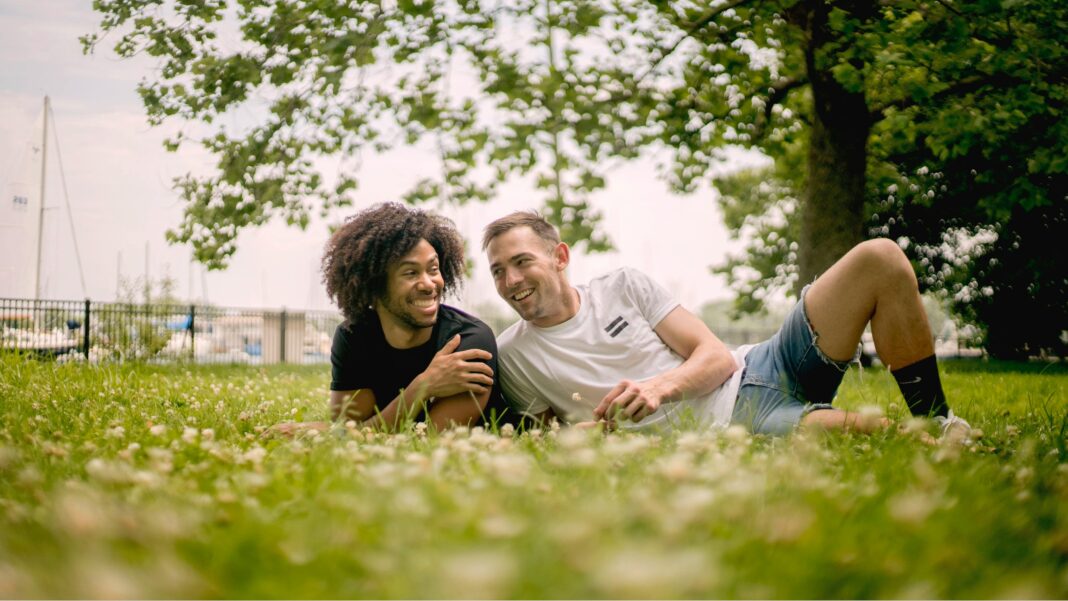Maybe you had sex on the first date. Maybe you’ve been sleeping over for weeks. Maybe you’ve cooked him everything in your culinary repertoire. Maybe you’ve met his parents.
None of that will prepare you for travelling with your boyfriend for the first time, especially if it’s for more than a weekend. Collaborating on a shared holiday—and getting through it without a meltdown—is a special achievement.
But it’s not necessarily a dealbreaker. Hopefully you’ll learn lessons from the mistakes you make on your first trip that can be applied to future ones. Not every perfect husband is a perfect travelling companion. But there are a few strategies that you can employ that will help you make the best of a sometimes awkward situation when you are travelling with your gay boyfriend for the first time. Here are Wander+Lust’s top six tips for travelling with a partner for the first time.
Custom or off-the-rack?
Longer recreational trips can be divided into two types. One is a custom trip, planned by a couple. It’s a big relationship test. The duo will need to decide together when the trip will occur and where they’ll go. They’ll need to come up with a shared idea of an itinerary (whether it’s sitting by a pool all day or seeing 14 countries in 12 days) and agree roughly on a budget that works for both parties.
Power struggles may emerge in this process. The less-passionate person might find themselves making compromises (“I’ve always dreamed my first trip to Asia would be Vietnam, but I guess I could start with Sri Lanka”). It should quickly become clear if one person loves to research and book hotels, plane tickets and experiences, to the delight of the non-planner. Or if both do (conflict? synergy?) or neither (mutual disappointment?).
By contrast, an off-the-rack trip is when one party has an obligation (work, special occasion, annual event, etc.) or routine (“I’ve gone to Mykonos every summer for the past decade”) that the other party gets invited along to. This option requires less cooperation and fewer personal revelations—up front. The pre-trip requirements are that the trip leader be very clear about what the plus-one is getting into (“You’ll probably be spending $10,000 and will sleep in the room next to my grandmother”) and the plus-one be very clear about their hopes, fears and aversions (“Didn’t I tell you I’m afraid of large bodies of water and can’t eat rice?”).
On such a trip, the leader needs to be diligent in including the plus-one in as many activities as possible, checking with how they’re doing and giving them the control they desire (“We can do whatever you’d like after the wedding reception.”) The plus-one needs to be flexible, while also setting limits. Both parties will need to suspend judgments: the leader’s loud friends may not give the plus-one the opportunity to demonstrate their sense of humour, the plus-one might discover that the socio-economic background of the leader doesn’t match how he presents in everyday life. If the relationship continues beyond this initial experience, it’s nice to give the plus-one an opportunity to be the leader on the next off-the-rack trip.
Note that no matter how much you planned together, or how routine an off-the-rack trip has been in the past, things may still go wrong. Keep calm. You’ll get through it. Whether you’ll stay together afterwards is another question.
How are you dividing the duties and the bills?
Whatever the organizational inclinations of each member of the couple, there should be some agreed-upon method for divvying up the labour and the costs. If each guy can do the tasks that he loves (for example, booking flights or researching restaurants), it might be a coupling made in heaven. For every control freak, there’s hopefully someone who just wants to be along for the ride.
But each partner should be prepared to do some of the heavier lifting. This might evolve as the trip goes along: for example, someone who thinks he’s a bad navigator may turn out to have a nose for cool cocktail places.
If there are competing interests (say, an outdoorsy type travelling with an architecture nerd), a fun way to create new shared interests is taking turns “leading” an excursion, with the enthusiast indoctrinating the rookie into the activity.
Boyfriends on their first trip together probably don’t share a bank account. They’ll need to decide how to split costs. Down the middle? As you go or after the end of the trip? (Apps like Splitwise make it easy to divide travel expenses.) If there is income disparity, then taking turns hosting can make sense: the richer traveller covers the luxury hotel, while the one with the tighter budget covers the camping. In fact, if there is a notable income gap, purposefully planning the trip with a mixture of cheap-and-cheerful moments and indulgent ones can make things seem fairer. Someone on a tight budget doesn’t need the stress of watching their partner order round after round of $30 cocktails, knowing the bill is going to be split 50/50.
Being fair, generous and open is much more important than eating, drinking and seeing exactly what you want, regardless of whether your companion is into it or not. If compromising is an issue, a solo trip and some video calls might be the solution.
How gay is this trip going to be?
We all have multiple dimensions. Sometimes we love learning about the history of a place we’ve dreamed all our lives about visiting, while other times we want to ingest as many poolside piña coladas and as humanly possible. Gay couples have the added dimension of being able to choose a destination where gayness is a major component.
Choosing a gay travel mecca makes some things simple. The list of possible destinations is not endless, so a couple can easily negotiate their choice. Safety will not be much of a concern. Locals and fellow travellers shouldn’t raise an eyebrow about your personal style or constant PDAs. In destinations that embrace LGBTQ2S+ travellers, it’s often effortless to find gay and gay-friendly venues and experiences—in fact, it might be hard to avoid them.
The other side of this equation is that gay meccas can be overwhelming (and pricey). All the gay might drown out other interests—happy hour becomes more important than, say, curiosity about snorkelling. It can distract from what is perhaps the main purpose of the trip: learning more about each other. Obviously, if a partner’s head turns every time a tall bearded man walks past, his companion learns something about him. But that kind of knowledge might trigger insecurities and jealousies. Depending on how far along a relationship is, a gay destination might create unnecessary pressure.
What are the sexual dynamics of the trip?
But then again, some couples have flirting, cruising and being together in hypersexual situations all figured out. Sexual adventure might be a key ingredient of their ideal trip. Having an open relationship abroad can be more freeing than having one at home—there’s less of a chance of hometown gossips taking notice of what a couple is up to.
In fact, many of the limits placed on an open relationship at home can disappear while on vacation. Work schedules, shared spaces, day-to-day obligations and a “done him, done him” local gay population can get in the way of many domestic sexual adventures. The “no friends or acquaintances” rule, for couples that follow it, is moot in a strange land.
But there’s a catch. Fewer natural limits means couples have to be more open and explicit about what they want and don’t want to do, separately or together. Guys from places too small to even have a gay bar might have to figure out which of several bathhouses or sex venues to choose from, some of which might be dedicated to niche interests like leather and fetish. One half of the couple might see a trip as an opportunity to experiment with drugs or new sexual practices, while the other might want to continue the routine they’ve already established. Do they have the same priorities?
Whatever the arrangement, it’s best to figure these things out before a trip. Nobody wants to be in the middle of an orgy while their partner is crying in the next room or, without saying goodbye, in a taxi headed to another party on the other side of town. It’s not a bad idea to come up with a safe word that can be discreetly worked into a conversation with new friends, to veto an unwanted situation.
Hookup apps can be helpful in making local connections, but a vacation spent staring at a phone is no vacation at all. Time limits can be helpful in managing screen time. “If we haven’t found a muscle top who is ready to be on his way in the next hour, we’ll check out that bar we walked past yesterday.”
We’re all a little special, aren’t we?
We may know exactly how our partner likes his coffee when he makes it at home. It’s on a trip that we discover he’s a germ freak who doesn’t want to drink out of any cup he hasn’t washed himself. We’re all a little weird; being out of our comfort zones can make us even weirder. Seeing behaviour we don’t like on a trip might be a red flag—or it may be the one-time panic of someone who is out of their element. Our carryon bag is not the only baggage we bring with us when we travel.
Sharing the same hotel room and the same holiday schedule doesn’t mean a couple has to be perpetually in sync. Early rising yoga people and runners can meet up with their sleepyheads after breakfast. Being in a relationship is not being twins. Planning for some solo time is healthy and it gives a couple something to talk about when they next meet.
What exactly are you packing?
Some guys choose outfits in advance for each activity on an itinerary, meticulously vacuum sealing their items into a single carryon bag. Others haphazardly throw as many T-shirts and jockstraps into the maximum number of bags permitted by the carrier. We all know who is correct, but there is little to be done about the other approach except roll one’s eyes.
For this reason, we suggest that each guy be responsible for his own packing and managing his own luggage. Joint custody of bulky items (a clothing steamer or value-sized tube of sunscreen, for example) can help save space. Coordinating activity-specific clothing items (bathing suits, leather harnesses, singlets, hiking boots) can prevent last-minute shopping expeditions.


